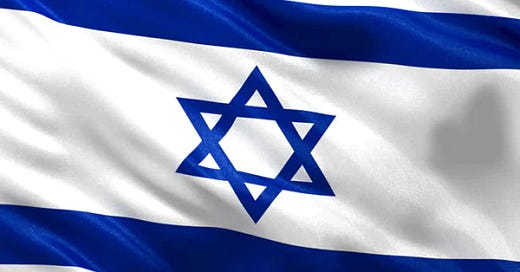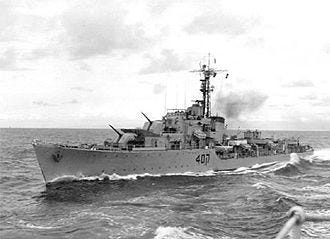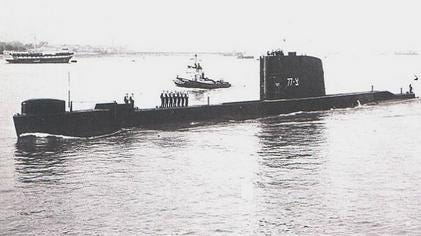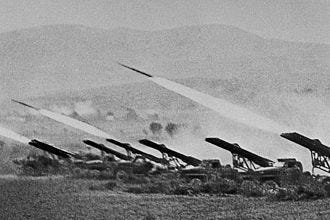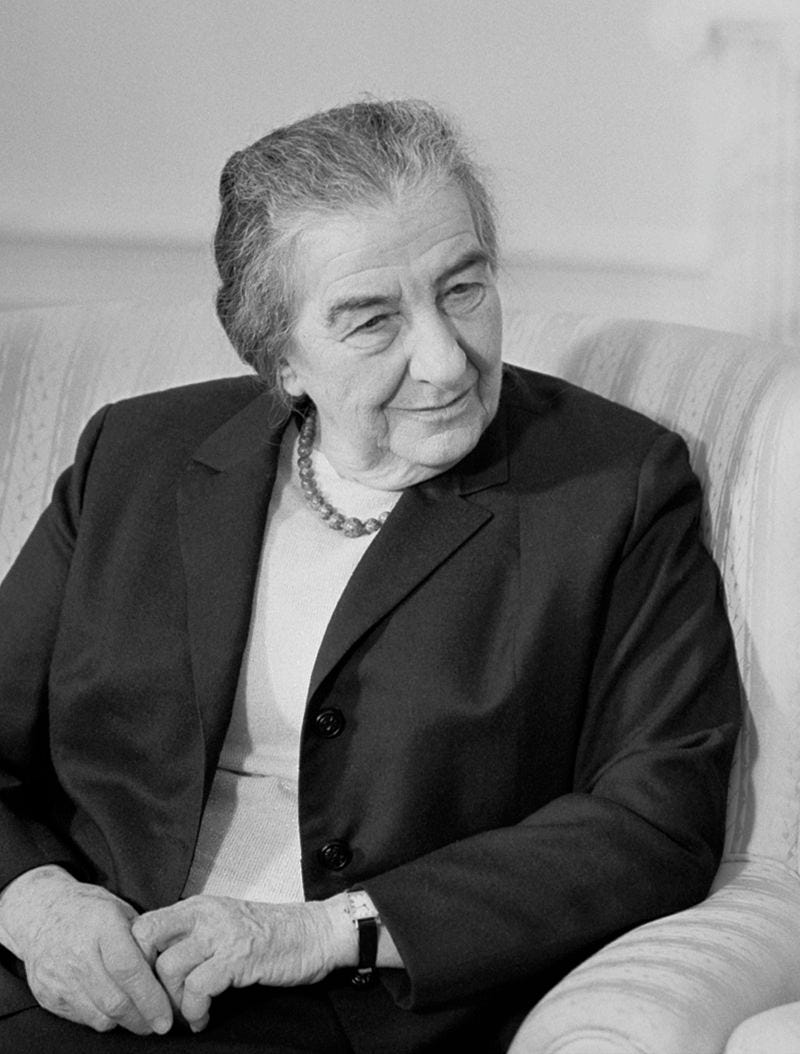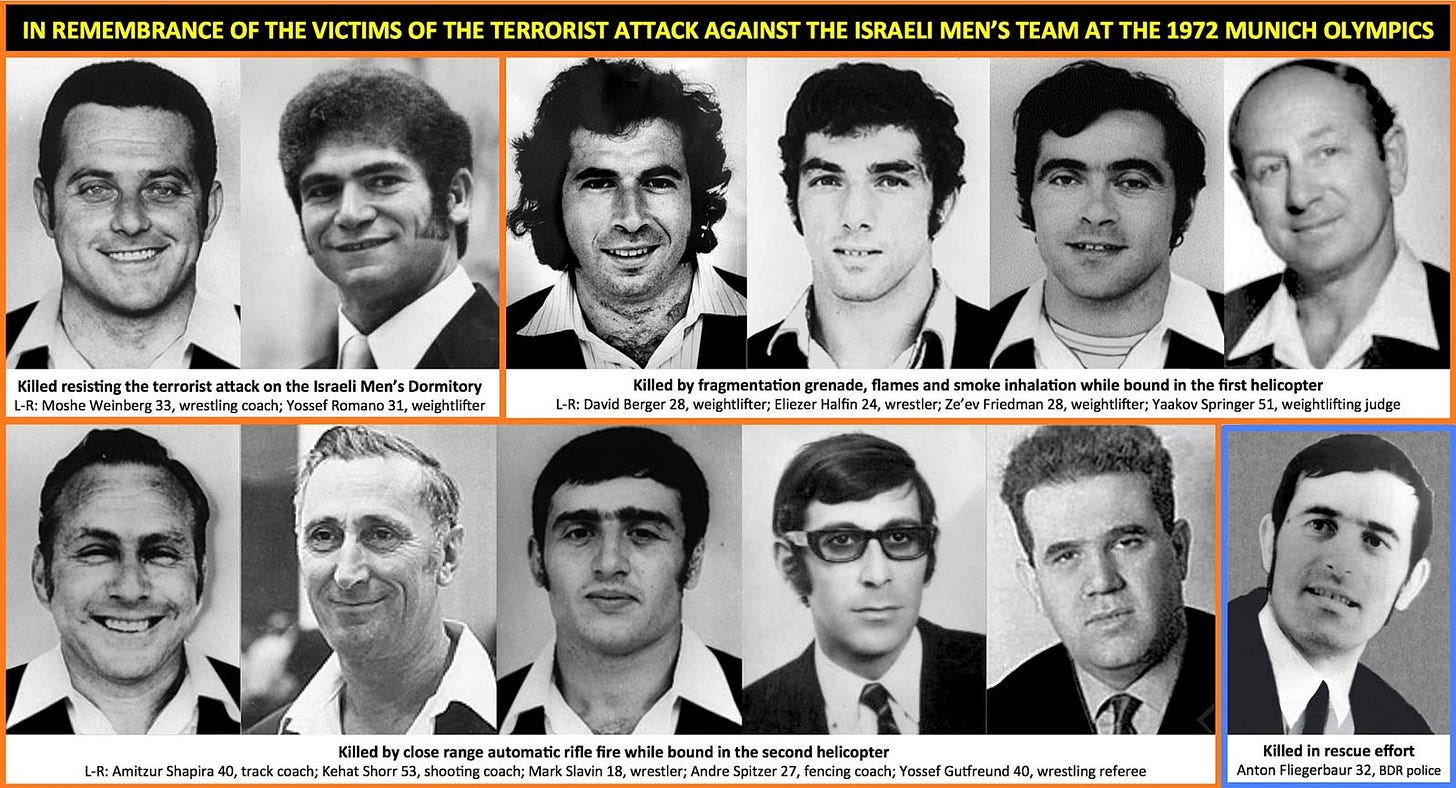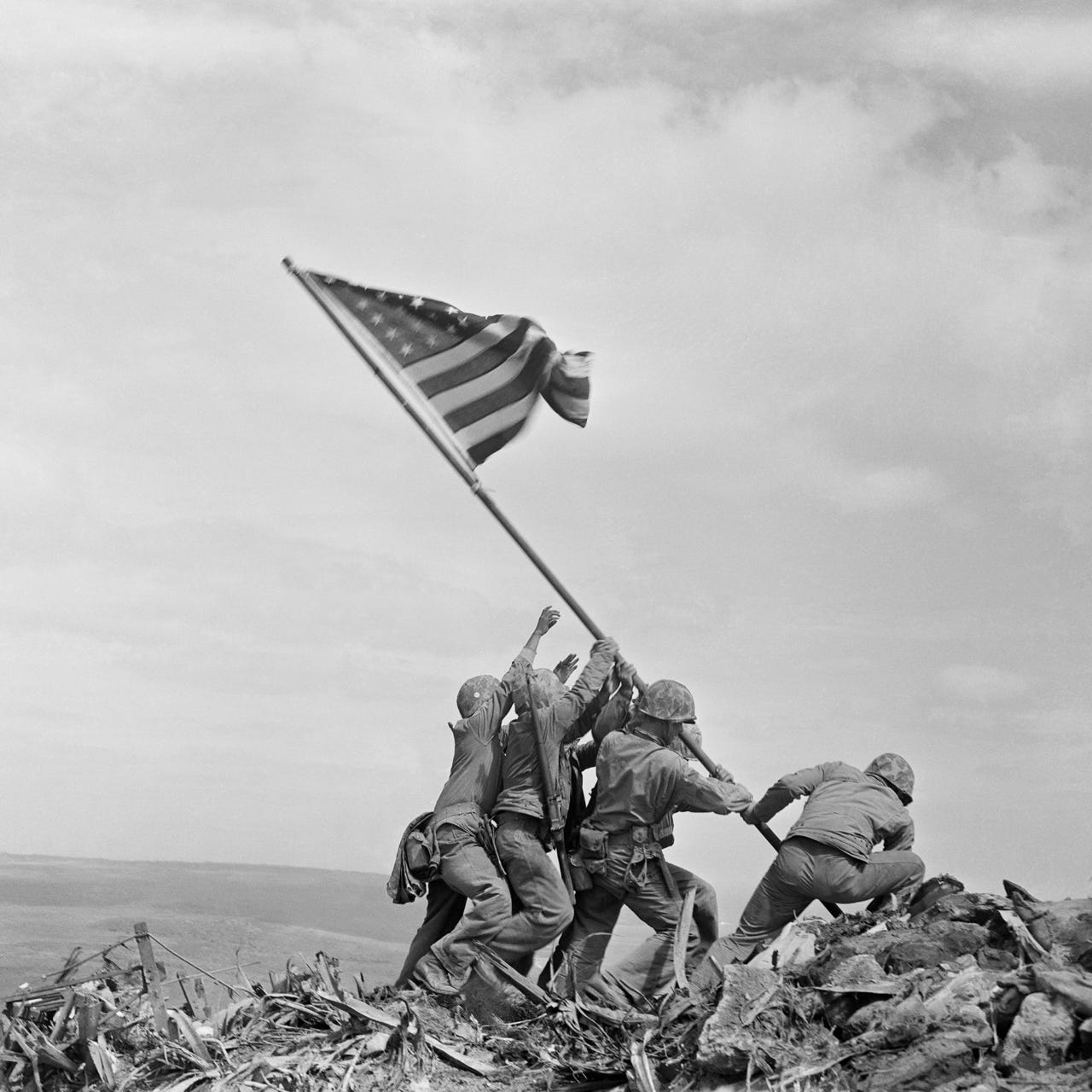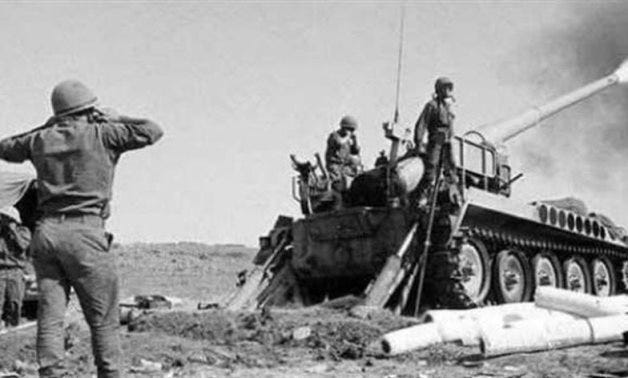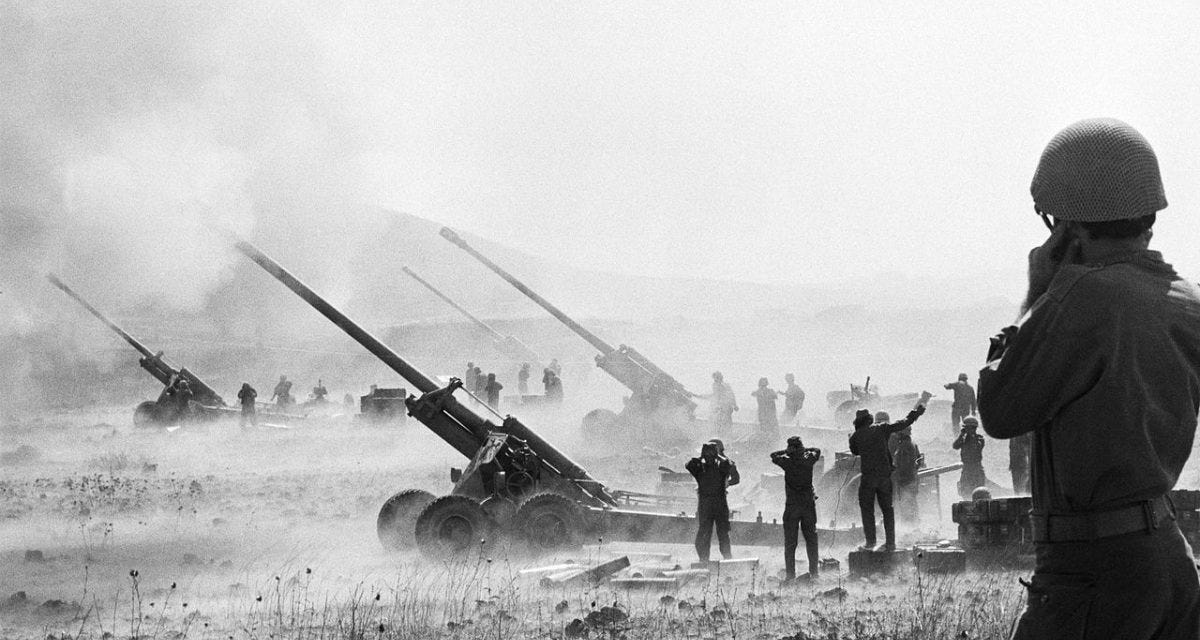In my last post, I discussed the Six Day War. Click the link below if you missed it.
Today I will go through the six years between that war and the next as well as the build-up to the Yom Kippur War.
1967
June 10 1967: The Moroccan Quarter, an 800-year-old neighborhood in the southeast corner of the Old City of Jerusalem, is demolished by the Israeli government to create a plaza in front of the Western Wall in order to make public access to the Western Wall easier.
June 17 1967: The Israeli government transfers day-to-day control of the Temple Mount site to the Islamic Waqf.
June 27 1967: Israel annexes East Jerusalem. Arab residents of East Jerusalem are given a permanent resident status in Israel.
June 29 1967: Jerusalem is unified, as Israel removed all barriers separating the Old City from the Israeli sector.
September 1 1967: The Khartoum Resolution, issued at the conclusion of an Arab League summit in Khartoum, Sudan, adopts the "Three No's" – "no peace with Israel; no recognition of Israel; no negotiations with Israel."
October 21 1967: In international waters off Port Said, the Israeli Navy destroyer INS Eilat is hit by three Soviet-made Styx missiles fired by Egyptian missile boats. An Egyptian Komar class missile boat within the harbor at Port Said fired two missiles at the Israeli destroyer. The Eilat's radar show any threats because the Egyptians launched the missiles from within the port, among other vessels.
When the missiles were detected The Eilat's captain ordered evasive action, but the first missile hit the ship just above the waterline, with the second missile hitting two minutes later, causing additional damage and casualties. While INS Eilat began to list heavily, the crew tended to the wounded and engaged in rescue and repair operations while waiting for additional ships of the Israeli Navy to come to their rescue. Approximately one hour later another missile boat fired two more Styx missiles. The third missile hit the Eilat amidships, causing more damage and further fires, while the fourth went astray and crashed in the water nearby. Eilat sank about two minutes later. Out of a crew of 199, 47 were killed or missing and 100 were wounded. Israel retaliates by shelling Egyptian refineries along the Suez Canal.
September 4 1967: A bomb at the Tel Aviv central bus station kills one person and injures 72.
1968
January 1 1968: Haim Bar-Lev is appointed as the eighth Chief of Staff of the Israel Defense Forces.
January 25 1968: The Israeli submarine INS Dakar and her entire 69-man crew were lost en route to Israel. Despite extensive searches over the course of three decades, its wreckage was not found until 1999, when it was located between Cyprus and Crete in 9,800 feet of water. The exact cause of Dakar's sinking remains unknown.
March 21 1968: The Battle of Karameh a 15-hour military engagement between IDF forces and a combined force of the Palestine Liberation Organization (PLO) and the Jordanian Army, during the War of Attrition. It was planned by Israel as one of two concurrent raids on PLO camps, code named Operation Inferno but the operation in Karameh turned into a full-scale battle. The IDF lost 33 killed and 131 wounded. Jordan suffered 108 killed and 250 wounded, while the PLO had 156 killed and 100 wounded.
May 2 1968: The Israel Broadcasting Authority commences television broadcasts.
July 23 1968: The only successful hijacking of an El Al aircraft takes place, when a Boeing 707 carrying ten crew members and 38 passengers is taken over by three terrorists. The aircraft, El Al Flight 426, en route from Rome to Tel Aviv, is diverted to Algiers by the hijackers. The following day, all non-Israeli passengers were released. Over the subsequent weekend ten women and children were released. The remaining 12 Israeli passengers, and the crew of 10 were held as hostages for the remainder of the hijacking. The hijackers were identified as members of the Popular Front for the Liberation of Palestine. They were equipped with Iranian and Indian passports and had carefully chosen by the PFLP because of their occupations (a pilot, a colonel in the Palestinian army, and a karate teacher). After five weeks of negotiations by the Israeli and Algerian governments all the hostages and the hijackers, were released in exchange for 16 convicted Arab prisoners.
September 4 1968: On the one year anniversary of the first bombing, terrorists set off another bomb in the Tel Aviv central bus station. One civilian was killed and 51 were injured.
December 26 1968: Two PFLP members attacked El Al flight 253, on the ground in Athens, as it was preparing to depart. One passenger, Israeli Leon Shirdan, a marine engineer, was shot dead. Two unidentified women were injured, one by a bullet, the other as she leaped from the jet when the door was opened. The two terrorists were 19-year-old Naheb Suleiman, and 25-year-old Mahmoud Mohammad Issa Mohammad. The two dashed out of the transit lounge of the Athens Airport, ran 200 yards to the plane, Mohammad fired at the plane with a submachine gun, while Suleiman threw two hand grenades, creating panic among the ten crew members and 41 passengers aboard. The two men were taken into custody by Greek authorities, both confessed they were members of the PFLP and had planned to kill all the Israelis aboard and then destroy the plane. Mohammad was sentenced to 17 years and 5 months in prison, but was freed after less than 4 months after another Palestinian terrorist group hijacked a Greek airliner and demanded his release. Subsequently, he successfully hid his terrorist past and emigrated to Canada. Once Canadian authorities learned of his crime, a protracted extradition process culminated in his extradition to Lebanon in 2013. I could not find any information on Suleiman.
December 28 1968: Commandos from the IDF's elite Sayeret Matkal destroy 14 airplanes belonging to Middle East Airlines (MEA) at the Beirut International Airport, in response to the attack on an Israeli airliner in Athens two days before. There are no casualties reported but 43.8 million dollars in damage.
1969
January 1 1969: Two are killed and dozens wounded when Katyusha rockets are fired from Lebanon, into Kiryat Shmona. The first rocket attack by the PLO.
February 26 1969: Israeli Prime Minister Levi Eshkol dies of a heart attack. Yigal Allon is appointed as the acting Prime Minister of Israel and held office until March 17.
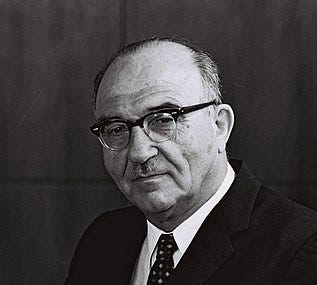
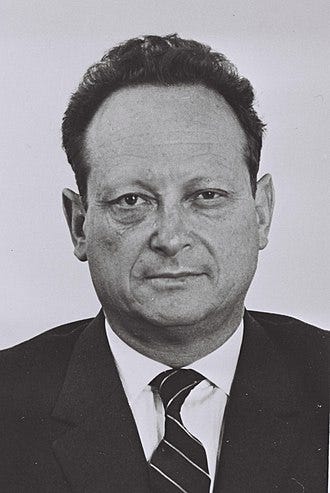
March 17 1969: Golda Meir is elected Prime Minister of Israel. The 14th Government is approved that day and the members are sworn in.
July 8 1969: A series of air battles takes place over the Golan Heights and Damascus, as part of the War of Attrition, during which seven Syrian MIGs are shot down.
September 9 1969: During the War of Attrition, an IDF force inside six Egyptian T-55 tanks and three Egyptian BTR-50 armored personnel carriers are landed on the Egyptian side of the Suez canal disguised as an Egyptian military force. The IDF armored force raids Egyptian military bases along the west coast of the Gulf of Suez attacking Egyptian radar stations, military vehicles and other military targets. The Egyptian Army suffers 200 casualties and had twelve outposts destroyed. The Israeli forces suffers no losses.
February 15 1969: Four members of PFLP machine-gun El Al flight 432, a Boeing 707 preparing for takeoff at the Kloten Airport near Zurich. Several crew members are wounded in the attack and plane is damaged. The co-pilot, who was severally wounded, dies from his wounds a month later.
February 20 1969: The PFLP bomb a Jerusalem supermarket; two Israelis are killed and twenty others are wounded.
August 29 1969: A PFLP terrorist cell led by Leila Khaled hijacks TWA Flight 840 on its way from Los Angeles to Tel Aviv, diverting the Boeing 707 to Damascus. They evacuated the aircraft and blew up the nose section of the aircraft. The Syrian authorities arrested the hijackers and immediately released the 12 crew members and all but two of the passengers. By October the two hijackers were released without charge. The hijackers main aim was to kidnap the Israeli ambassador to the United States, Yitzhak Rabin, whom they mistakenly believed would be on this flight.

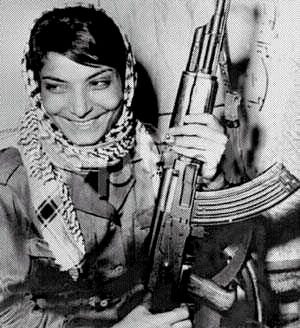
December 7 1969: After being held in a Syrian prison for 98 days, two Israeli passengers taken from the hijacked TWA 840, are released in a prisoner exchange deal for 71 Syrian and Egyptian soldiers.
1970
January 22 1970: The IDF launches Operation Rhodes, a heliborne raid against the Egyptian island of Shadwan. Israeli paratroopers and Shayetet-13 naval commandos take control of the island for 36 hours before leaving with 62 captured Egyptian soldiers and radar equipment.
January 24 1970: A truck loaded with ammunition accidently explodes in a military area of Port Eilat. 21 are killed and dozens are injured.
February 10 1970: PFLP terrorists attack a bus containing El Al passengers at the Munich airport, killing one passenger and wounding eleven.
February 21 1970: Swissair Flight 330, en route from Zürich to Tel Aviv suffers severe damage when a bomb explodes nine minutes after takeoff. 47 people die when the aircraft crashes while attempting an emergency landing at Zürich. The PFLP claims responsibility for the attack.
May 4 1970: Two Arabs break into the Israeli Embassy in Asunción, Paraguay, and open fire with pistols, killing one person and seriously wounding another.
May 22 1970: PLO terrorists attack the community school bus from the Israeli moshav Avivim, killing nine children and three adults, and crippling 19 children for life.
July 30 1970: A large-scale dogfight takes place west of the Suez Canal. Israeli pilots shoot down five MiG-21s flown by Soviet pilots, only one Israeli Mirage is damaged.
August 7 1970: A cease-fire agreement between Egypt and Israel ends the War of Attrition (See below).
December 30 1970: The worst natural disaster since the founding of the State of Israel occurs when a 40 foot high cliff breaks loose because of heavy rains. The rockfall crushes the mess hall of the IDF base near Neot HaKikar, killing 19 soldiers and a civilian, ten soldiers were injured, three of them severely.
September 6 1970: PFLP terrorists simultaneous hijack four airliners. TWA Flight 741, a Boeing 707, out of Frankfort Germany and Swissair Flight 100, a DC-8, from Zurich were forced to land at Dawson's Field, an unused World War II airstrip in the Jordan desert. PFLP members Patrick Arguello (a US citizen) and our new friend, Leila Khaled, attempted to hijack El Al Flight 219, another 707, from Amsterdam, but were overpowered by the passengers and crew. Arguello was shot four times and died before the plane landed at Heathrow Airport, where Khaled was taken into custody. Two additional PFLP hijackers who were prevented from boarding Flight 219, hijacked Flight 93, a Pan Am 747, diverting the large plane first to Beirut then to Cairo, instead of Dawson’s Field, where it wouldn’t have been too big to land. It is evacuated and destroyed by explosives by the hijackers, who were arrested by Egyptian authorities. On September 9, a fifth plane, BOAC Flight 775, a Vickers VC-10 from Bahrain, was hijacked by a PFLP sympathizer and taken to Dawson's Field in order to pressure the British to free Khaled.
September 7 1970: The hijackers held a press conference for 60 members of the media who had made their way to what was being called "Revolution Airport." About 125 hostages were transferred to Amman, while the American, Israeli, Swiss, and West German citizens were held on the planes. Jewish passengers were also held.
September 11 1970: The Dawson's Field hijackers release 88 of their hostages. The remaining hostages, mostly Jews and Israeli citizens, are moved to various places around Amman.
September 12 1970: The PFLP blow up the three empty planes.
September 16 1970: King Hussein declared martial law and initiated military actions against the PLO and the PFLP to expel them from Jordan later known as Black September.
September 25 1970: Two weeks after the start of the crisis, the remaining hostages were recovered from locations around Amman and exchanged for Leila Khaled and several other PFLP prisoners.
September 27 1970: Black September ends with an Egyptian brokered deal to expel the PLO and PFLP to Lebanon. During the conflict 3,400 PLO fighters were killed along with 300 Syrians and 537 Jordanians.
September 28 1970: Gamel Abdel Nasser, President of Egypt since 1956 dies of a heart attack. He is succeeded by Anwar Sadat.
November 7 1970: The Tel Aviv Central Bus Station is bombed for the third time, killing one and injuring 24.
1971
May 15 1971: Three members of the Turkish Liberation Army, an underground militant organization linked to the PLO, kidnapped and executed Israeli consul-general Efraim Elrom in Ankara.
1972
January 1 1972: David Elazar is appointed as the ninth Chief of Staff of the Israel Defense Forces.
March 27 1972: – President of Uganda Idi Amin ordered all Israelis to leave Uganda. Although Israel had trained Ugandan paratroopers in the past ten years, Amin decided to break off relationship after forming an alliance with Libya.
March 15 1972: King Hussein of Jordan unveiled his plan for the "United Arab Kingdom", a federation consisting of the existing Hashemite Kingdom of Jordan, and a Palestinian Arab state on Jordan's former territories on the Israeli occupied West Bank, each with their own parliament, united under one monarch. The UAK would be dependent upon a treaty between Jordan and Israel. The PLO and other Arab nations opposed the plan.
May 19 1972: The 1972 Population Census shows that there are 3,147,683 inhabitants in Israel.
October 4 1972: President of Egypt Anwar Sadat convened a meeting of his armed forces leaders and announced plans to prepare for a limited war with Israel.
May 8 1972: Four PLO terrorists, Ali Taha Abu Snina, Abed al-Aziz Atrash, Rima Tannous and Theresa Halsa. hijack Sabena Flight 571 en route from Brussels to Tel Aviv. Defense Minister Moshe Dayan and Transport Minister, and future Prime Minster Shimon Peres, conducted negotiations with the hijackers while preparing a rescue operation, code-named Operation Isotope.
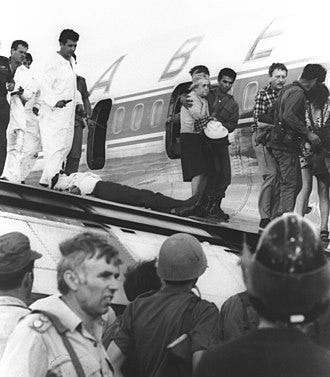
On 9 May 1972 at 4:00 p.m. the rescue operation began when a team of 16 Sayeret Matkal commandos, led by Ehud Barak and including Benjamin Netanyahu, both future Prime Ministers, approached the aircraft disguised as aircraft technicians in white coveralls. They convinced the hijackers that the hydraulic system needed repair and once they were near the plane, they stormed the aircraft. The two male hijackers were killed and the two female hijackers were captured. Of the 90 passengers on board, three passengers were wounded in the exchange of fire, one of whom later died of her injuries. Halsa and Tannous were eventually sentenced to 220 years in prison, but were freed in November 1983, in a prisoner exchange after the 1982 Lebanon War.
May 30 1972: Three Japanese Red Army members, acting on behalf of the PFLP enter the waiting area of Lod Airport near Tel Aviv, throw hand grenades and shoot indiscriminately at airport staff and travelers. 26 people, including 17 tourists from Puerto Rico, are killed and 80 are wounded. Most of the terrorists are killed but Kozo Okamoto was captured and eventually sentenced to life in prison. He was released in 1985 in a prisoner exchange.
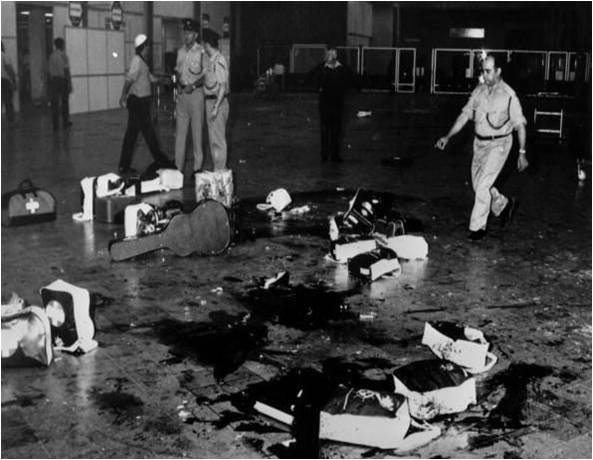
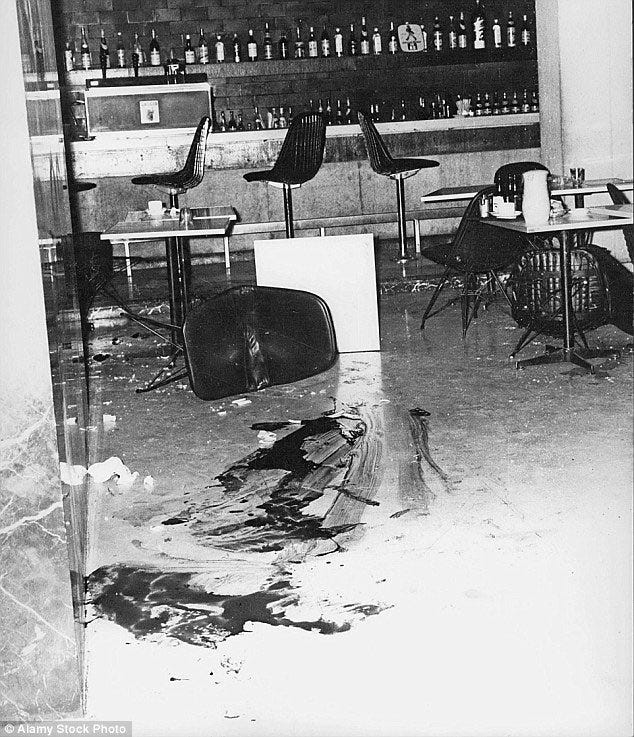
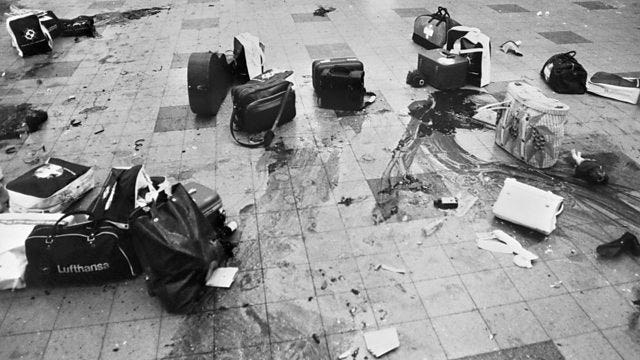
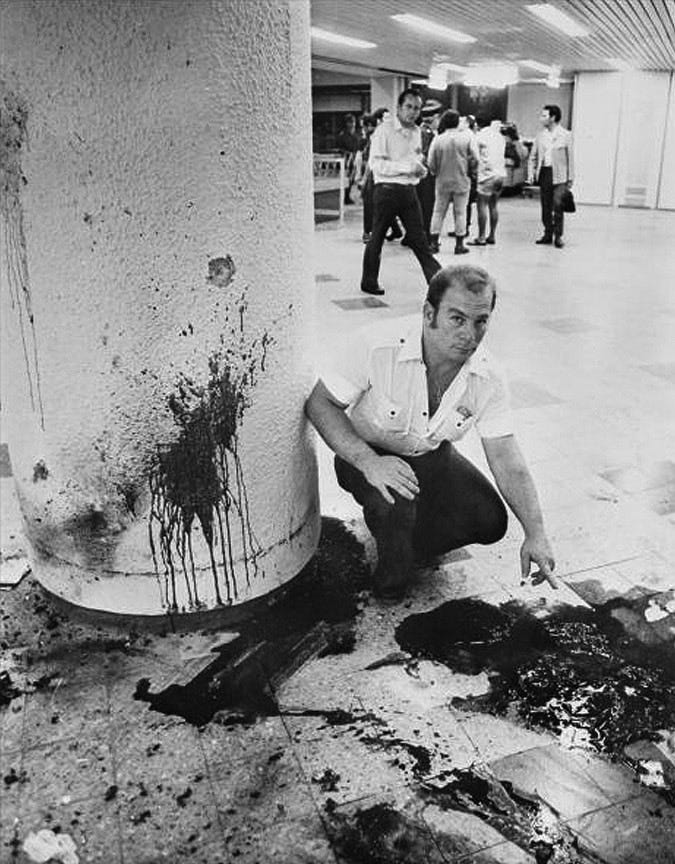
September 5-6 1972: During the 1972 Summer Olympics in Munich Germany, Black September (it is not an actual terrorist organization, it was a name Fatah used to deflect blame for operations away from themselves), who infiltrated the Olympic Village, killed two members of the Israeli Olympic team and took nine others hostage. Shortly after the hostages were taken, Luttif Afif, the leader and spokesman of the group, demanded the release of 234 Palestinian prisoners who were being held in Israeli jails, plus the West German–imprisoned founders of the Red Army Faction Andreas Baader and Ulrike Meinhof.
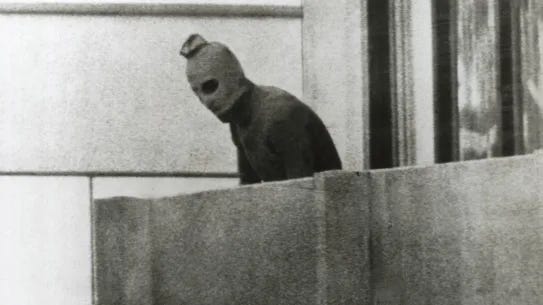

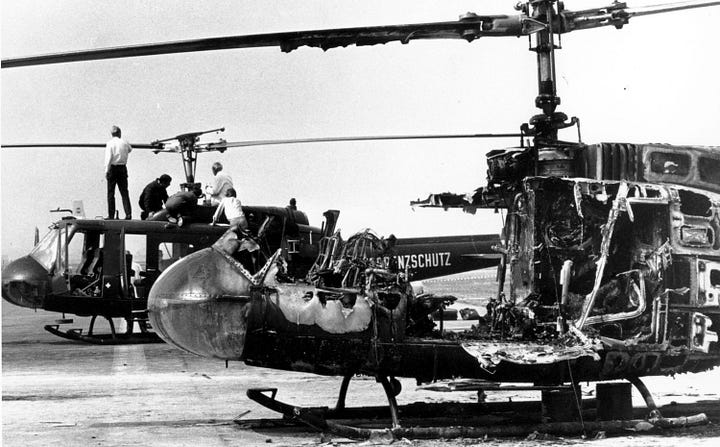

West German police ambushed the terrorists at the Fürstenfeldbruck Air Base after telling the terrorist they would have safe passage to Egypt. The ambush went horribly wrong, killing all the hostages and five of the eight Black September members. The West German government was criticized for the poor execution of its rescue attempt and its overall handling of the incident. The three surviving perpetrators, Adnan Al-Gashey, Jamal Al-Gashey and Mohammed Safady were arrested, only to be released the next month in the hostage exchange that followed the hijacking of Lufthansa Flight 615.
September 8 1972: In retaliation for the killing of nine Israeli Olympic athletics, Israel's air force bombed Palestinian strongholds in Syria and Lebanon.
September 19 1972: a package bomb sent to the Israeli Embassy in London kills Ami Shachori, an Israeli attaché at the Israeli Embassy in London. The letter had been sent by Black September.
December 28 1972: Members of Black September occupy the Israeli embassy in Bangkok, Thailand, holding twelve hostages. Though their demands are not met, negotiations secure the release of all the hostages and the Black September militants are given safe passage to Cairo.
October 16 1972: At 10:30 pm in Rome, two Mossad agents shoot Wael Zwaiter eleven times as he returned to his apartment. Zwaiter, suspected by Mossad to have been part of the Black September planning for the Munich massacre. This was the first killing in Operation Wrath of God.
October 29 1972: Lufthansa Flight 615 was seized by sympathizers of Black September after takeoff from the Beirut Airport and its way to Frankfort, Germany. The hijackers demanded that the three surviving Munich Massacre perpetrators be released. The terrorists were loaded aboard the personal jet of Lufthansa CEO, Herbert Culmann, and taken to Zagreb Airport in Czechoslovakia. Flight 615 was refueled and the Black September prisoners were allowed to board the plane. The hijacked plane was flown to Tripoli, where all the hostages were released. The liberated Munich attackers were granted asylum by Libyan leader Muammar Gaddafi.
December 8 1973: Dr. Mahmoud Hamshari, the PLO representative in France, was killed by a bomb, planted near his telephone, in retaliation for his suspected role in the 1972 Munich Massacre. The Mossad had planted the explosives while Hamshari was out of his house. After his return, an agent telephoned him to confirm his identity. The bomb was then detonated by a signal through the telephone line.
1973
February 21 1973: Libyan Arab Airlines Flight 114 (Boeing 727) is shot down by Israeli fighter aircraft over the Sinai Desert, after the passenger plane is suspected of being an enemy military plane. Only five (one crew member and four passengers) of the 113 on board survive.
July 1 1973: Colonel Yosef Alon, Air Force Attaché in the Israeli Embassy in Washington, was shot and killed outside his home in Chevy Chase, Maryland by Black September.
July 21 1973: In an Incident that became known as the "Lillehammer affair". Mossad agents assassinate a Moroccan waiter in Lillehammer, Norway. He had been mistaken for Ali Hassan Salameh, one of the leaders of Black September. Six Mossad agents were arrested by the Norwegian authorities receiving sentences ranging from one year to five and a half years, but were released and returned to Israel in 1975.
September 13: A large-scale aerial battle between the Israeli Air Force and the Syrian Air Force takes place over the Mediterranean Sea. 13 Syrian MiG-21s are shot down but only one Israeli plane.
September 19 1973: Ami Shachori, an agriculture counselor at the Israeli embassy in England, was assassinated by Black September, when he opened a letter bomb.
October 1 1973: The Likud party is founded by Menachem Begin in an alliance with several right-wing and liberal parties
April 9 1973: IDF Special Forces attack PLO targets in Beirut and Sidon Lebanon in Operation Spring of Youth three high-level PLO leaders were surprised and killed at home, along with other PLO militants. Several Lebanese security people and civilian neighbors were also killed. Two Israeli soldiers were killed during the operation.
The War of Attrition
The War of Attrition involved fighting between Israel, Egypt, Jordan, the PLO and their allies from 1967 to 1970. Following the 1967 Six-Day War, no serious diplomatic efforts tried to resolve the issues at the heart of the Arab–Israeli conflict. The 1967 Arab League summit formulated in September the "three no's" policy: barring peace, recognition or negotiations with Israel. The Egyptian President Gamal Abdel Nasser believed that only military initiative would compel Israel or the international community to facilitate a full Israeli withdrawal from Sinai and hostilities soon resumed along the Suez Canal. These initially took the form of limited artillery duels and small-scale incursions into Sinai, but by 1969, the Egyptian Army judged itself prepared for larger-scale operations. On March 8, 1969, Nasser proclaimed the official launch of the War of Attrition. This was characterized by large-scale shelling along the Suez Canal, extensive aerial warfare and commando raids. Hostilities continued until August 1970 and ended with an Egyptian brokered ceasefire. The boarders remained the same and there was no serious commitment to peace negotiations.
The Israelis suffered 367 soldiers killed and 359 civilians deaths. The also lost 26 aircraft. The Egyptians had 8,882 killed and 6,285 wounded both civilian and military. 60 aircraft were shot down and three Egyptian naval vessels were also sunk. Jordan suffered 300 killed and 150 wounded. Syria lost 500 with another 750 wounded. The PLO suffered 1,828 killed, 3,112 wounded and 2,500 captured.
Soviet and Cuban advisors to the Arab countries were also caught up in the fighting with the Soviets losing 100 killed and 187 wounded. They also had Five Soviet MiG-21 shot down. Cuban forces, who were deployed on the Syrian front, lost 180 dead and 250 wounded.
The lead-up to the Yom Kippur War
The Arab position, as it emerged in September 1967 at the Khartoum Arab Summit, was to reject any peaceful settlement with the State of Israel. The eight participating states, Egypt, Syria, Jordan, Lebanon, Iraq, Algeria, Kuwait, and Sudan, passed a resolution that would later become known as the "three no's": there would be no peace, no recognition and no negotiation with Israel. Prior to that, King Hussein of Jordan had stated that he could not rule out a possibility of a "real, permanent peace" between Israel and the Arab states.
Armed hostilities continued on a limited scale after the Six-Day War and escalated into the aforementioned War of Attrition, an attempt to wear down the Israeli position through long-term pressure. In December 1970, Egyptian President Anwar Sadat had signaled in an interview with New York Times that, in return for a total withdrawal from the Sinai Peninsula, he was ready "to recognize the rights of Israel as an independent state as defined by the Security Council of the United Nations." Gunnar Jarring, Special Representative of the Secretary-General for the Middle East Peace Process, coincidentally proposed a similar initiative four days later, on February 8, 1971. Egypt responded by accepting much of Jarring's proposals, though differing on several issues, regarding the Gaza Strip, for example, and expressed its willingness to reach an accord if it also implemented the provisions of UN Security Council Resolution 242. This was the first time an Arab government had gone public declaring its readiness to sign a peace agreement with Israel.
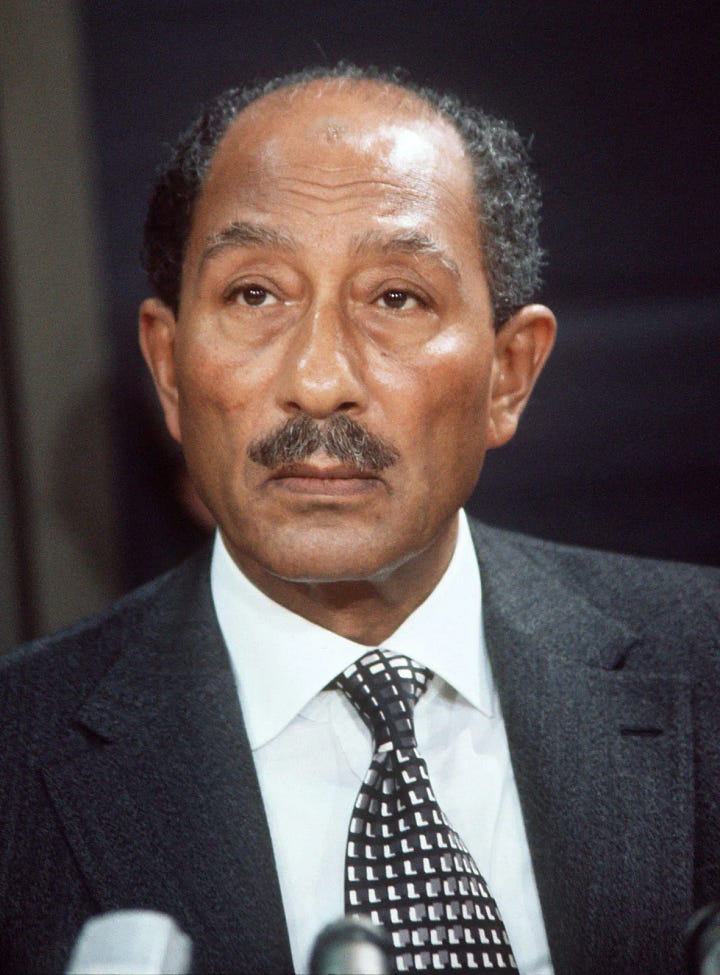

Golda Meir reacted to the overture by forming a committee to examine the proposal and possible concessions. When the committee unanimously concluded that Israel's interests would be served by full withdrawal to the internationally recognized lines dividing Israel from Egypt and Syria, returning the Gaza Strip and, in a majority view, returning most of the West Bank and East Jerusalem, Meir was angered and shelved the document. The United States was infuriated by the cool Israeli response to Egypt's proposal, and Under Secretary of State for Near East Affairs Joseph Sisco, informed Israeli Ambassador to the United States, Yitzhak Rabin, that "Israel would be regarded as responsible for rejecting the best opportunity to reach peace since the establishment of the state." Israel responded to Jarring's plan also on February 26 by outlining its readiness to make some form of withdrawal, while declaring it had no intention of returning to the pre-Six Day War lines. Abba Eban told the Knesset that the pre-June 5, 1967 lines "cannot assure Israel against aggression". Jarring was disappointed, and blamed Israel for refusing to accept a complete pullout from the Sinai peninsula.
The US, who considered Israel an ally in the Cold War and had been supplying arms to the Israeli military since the 1960s, believed that the regional balance of power hinged on maintaining Israel's military dominance over Arab countries, and that an Arab victory in the region would strengthen Soviet influence. Britain, on the other hand, believed that war between the Arabs and Israelis could only be prevented by the implementation of United Nations Security Council Resolution 242 and a return to the pre-1967 boundaries.
Anwar Sadat also had important domestic concerns in a war with Israel. The three years since Sadat had taken office were the most some of the demoralized in Egyptian history. They were made a laughing stock by Israel, they had lost their beloved leader and a desiccated economy added to the nation's despondency. However, even taking all of that into consideration, war was a desperate option. They had just recently rearmed enough that a war against Israel was even possible and more arms purchases would be necessary before a war was winnable. The Mossad estimated that Egypt wouldn’t be able to wage an effective war against Israel until 1975. Almost a full year before the war, in a meeting with the Supreme Council of the Armed Forces, Sadat declared his intention to go to war with Israel even without proper Soviet support.
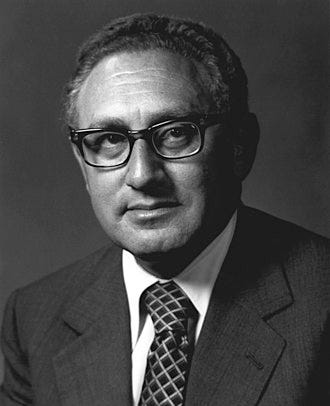
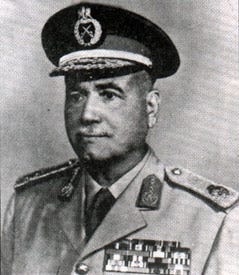
Four months before the war, Henry Kissinger made an offer to General Ahmad Ismail Ali, Egyptian Minister of Defense. Kissinger proposed returning the Sinai Peninsula to Egyptian control, along with a full Israeli withdrawal from the Sinai peninsula. Ismail said he would return with Sadat's reply, but Sadat was already determined to go to war. He declared that Egypt was prepared to "sacrifice a million Egyptian soldiers" to recover its lost territory.
From the end of 1972, Egypt began a concentrated effort to build up its forces, receiving MiG-21 Fishbed fighters, SA-2 Guideline, SA-3 Goa, SA-6 Gainful and SA-7 Grail antiaircraft missiles, T-55 and T-62 tanks, RPG-7 and AT-3 Sagger anti-tank weapons from the Soviet Union and based their tactics on Soviet battlefield doctrines. In addition, generals who had been appointed to their post because of their political reliability, the generals, who had in large part been responsible for the rout in 1967, were replaced with competent ones. Even with all the improvements, the Soviets thought little of Sadat's chances in any war. They warned that any attempt to cross the heavily fortified Suez Canal would incur massive losses. Both the Soviets and Americans were at that time pursuing détente and had no interest in seeing the Middle East destabilized again. In a June 1973 meeting with American President Richard Nixon, Soviet leader Leonid Brezhnev, had proposed Israel pull back to its 1967 border. Brezhnev said that if Israel did not, "we will have difficulty keeping the military situation from flaring up"—an indication that the Soviet Union had been unable to restrain Sadat's plans.
Between May and September 1973, the Egyptian Army conducted several week-long training exercises near the border. Ashraf Marwan, an Egyptian spy for the Mossad, inaccurately warned that Egypt and Syria would launch a surprise attack in the middle of May and then again in late June. The Israeli Army mobilized in response to both warnings, and these needless mobilizations led some Israelis to dismiss the actual war preparations, later in the year, as just another exercise. In late September, Israeli intelligence detected the movement of large numbers of troops towards the canal, they were dismissed as just part of the ongoing training exercise. The movement of Syrian troops towards the border were also detected, as were the cancellation of leaves and the call-up of reserves. These activities were considered puzzling, but not a threat because Israeli intelligence maintained that Syria would not attack without Egypt and Egypt would not attack until their newly purchased Soviet weapons arrived. Despite this belief, Israel sent reinforcements to the Golan Heights, those forces were to prove critical during the early days of the war.
In mid-September King Hussein of Jordan met with Sadat and Assad in Alexandria. Given the mutual suspicions prevailing among the Arab leaders, it was unlikely that he had been told any specific war plans. It was more likely that Sadat and Assad had raised the prospect of war against Israel in more general terms to feel out the likelihood of Jordan joining in.
On the night of September 25, Hussein secretly flew to Tel Aviv to warn Israeli Prime Minister Golda Meir of an impending Syrian attack. Meir asked the King if Syria was "Going to war without the Egyptians”. The King said he didn't think so. “ but I think Egypt will cooperate.” The warning was ignored, and Israeli intelligence indicated that the king had not said anything that was not already known. Throughout September, Israel received eleven warnings of war from well-placed sources. However, the Director of the Mossad General Zvi Zamir continued to insist that war was not an option the Arabs were considering, even after Hussein's warning. Zamir would later remark that "We simply didn't feel them capable of war.”
From September 27 to 30, two batches of reservists were called up by the Egyptian army to participate in the Suez exercises. Two days before the outbreak of the war, the Egyptian command publicly announced the demobilization of part of the reservists called up recently. Around 20,000 troops were demobilized, and subsequently some of these men were given leave to perform the Umrah (pilgrimage) to Mecca.
According to Egyptian General Mohamed Abdel Ghani El-Gamasy, Chief of Operations, the High Command had been very diligent in the planning of this operation. He said "On the initiative of the operations staff, we reviewed the situation on the ground and developed a framework for the planned offensive operation. We studied the technical characteristics of the Suez Canal, the ebb and the flow of the tides, the speed of the currents and their direction, hours of darkness and of moonlight, weather conditions, and related conditions in the Mediterranean and Red seas”. He explained further by saying: "Saturday October 6 1973 was the day chosen for the crossing, it was a fast day in Israel, and the moon on that day, shone from sunset until midnight”.
Zvi Zamir's concern grew on October 4, as additional signs of an impending attack were detected. Soviet advisers and their families left Egypt and Syria. Transport aircraft thought to be laden with military equipment landed in Cairo and Damascus and aerial photographs revealed that Egyptian and Syrian concentrations of tanks, infantry, and surface-to-air (SAM) missiles were at an unprecedented high. On the night of October 5, Marwan incorrectly informed Zamir that a joint Syrian-Egyptian attack would take place at sunset. It was this warning in particular, combined with the large number of other warnings, that finally goaded the Israeli High Command into action. Just hours before the attack began, orders went out for a partial call-up of the Israeli reserves.
Also on October 5, the 143rd Division commander General Ariel Sharon was shown aerial photographs and other information by his Divisional Intelligence Officer Colonel Yehoshua Saguy. General Sharon noticed that the concentration of Egyptian forces along the canal was far beyond anything observed during the training exercises, and that the Egyptians had amassed all of their crossing equipment along the canal. He then called General Shmuel Gonen, who had replaced him as head of Southern Command, and expressed his certainty that war was imminent.
We have now cover the inter-war period and the lead-in to the Yom Kippur War. In my next post, I will talk about the actual war and its effects. I hope you aren’t getting tired of these posts. It didn’t start off to be this long of series. The more I looked into it the more interesting it got and now I have to finish, no matter how many parts it takes. Please hang with me and before you know it I’ll be back to complaining about baseball.

